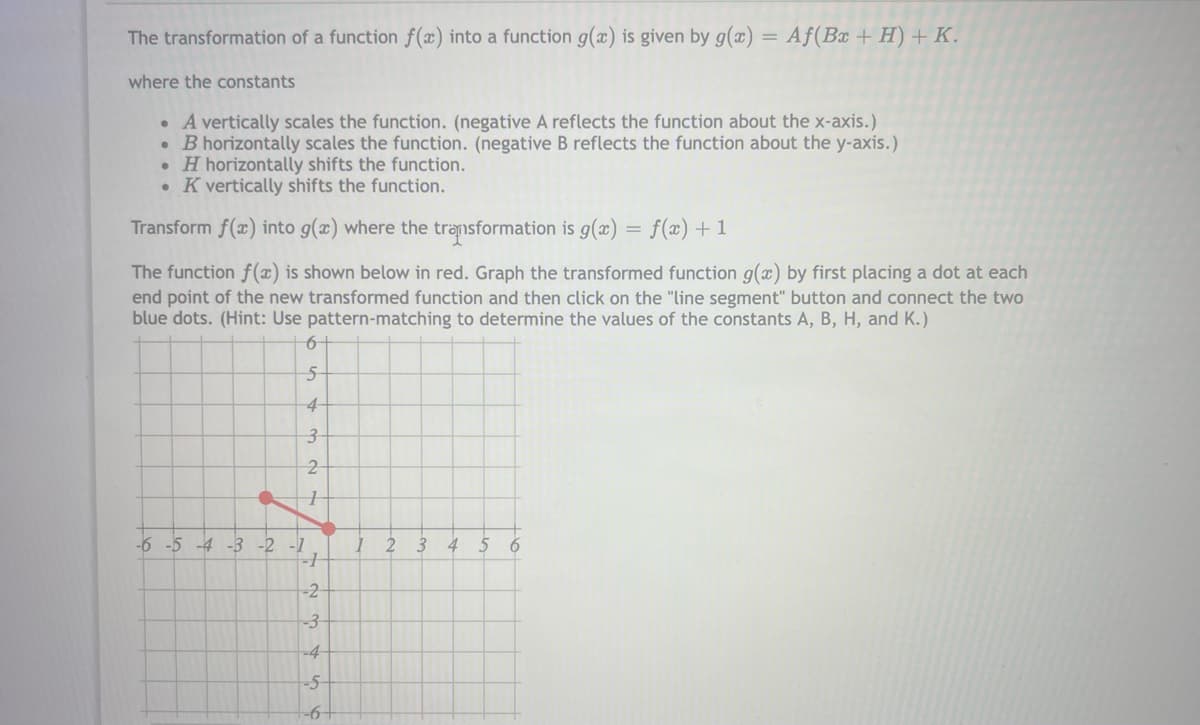The transformation of a function f (x) into a function g(x) is given by g(x) = Af(Bx + H) + K. %3D where the constants • A vertically scales the function. (negative A reflects the function about the x-axis.) • B horizontally scales the function. (negative B reflects the function about the y-axis.) • H horizontally shifts the function. • K vertically shifts the function. Transform f(x) into g(x) where the transformation is g(x) = f(x) +1 The function f(x) is shown below in red. Graph the transformed function g(x) by first placing a dot at each end point of the new transformed function and then click on the "line segment" button and connect the two blue dots. (Hint: Use pattern-matching to determine the values of the constants A, B, H, and K.) 61 4 2. -6-5 -4 -3 -2 -1 4 6. -2 -3 -4-
The transformation of a function f (x) into a function g(x) is given by g(x) = Af(Bx + H) + K. %3D where the constants • A vertically scales the function. (negative A reflects the function about the x-axis.) • B horizontally scales the function. (negative B reflects the function about the y-axis.) • H horizontally shifts the function. • K vertically shifts the function. Transform f(x) into g(x) where the transformation is g(x) = f(x) +1 The function f(x) is shown below in red. Graph the transformed function g(x) by first placing a dot at each end point of the new transformed function and then click on the "line segment" button and connect the two blue dots. (Hint: Use pattern-matching to determine the values of the constants A, B, H, and K.) 61 4 2. -6-5 -4 -3 -2 -1 4 6. -2 -3 -4-
ChapterP: Prerequisites
SectionP.4: Factoring Polynomials
Problem 84E: The rate of change of an autocatalytic chemical reaction is kQxkx2 where Q is the amount of the...
Related questions
Question

Transcribed Image Text:The transformation of a function f(x) into a function g(x) is given by g(x)
Af(Bx + H) + K.
%3D
where the constants
• A vertically scales the function. (negative A reflects the function about the x-axis.)
• B horizontally scales the function. (negative B reflects the function about the y-axis.)
• H horizontally shifts the function.
• K vertically shifts the function.
Transform f(x) into g(x) where the transformation is g(x)
f(x) + 1
The function f(x) is shown below in red. Graph the transformed function g(x) by first placing a dot at each
end point of the new transformed function and then click on the "line segment" button and connect the two
blue dots. (Hint: Use pattern-matching to determine the values of the constants A, B, H, and K.)
6-
4
-6 -5 -4 -3 -2 -1
3.
4
5
6
-2
-3
-4
-5
-6+
Expert Solution
This question has been solved!
Explore an expertly crafted, step-by-step solution for a thorough understanding of key concepts.
This is a popular solution!
Trending now
This is a popular solution!
Step by step
Solved in 2 steps with 1 images

Recommended textbooks for you


Algebra & Trigonometry with Analytic Geometry
Algebra
ISBN:
9781133382119
Author:
Swokowski
Publisher:
Cengage


Algebra & Trigonometry with Analytic Geometry
Algebra
ISBN:
9781133382119
Author:
Swokowski
Publisher:
Cengage